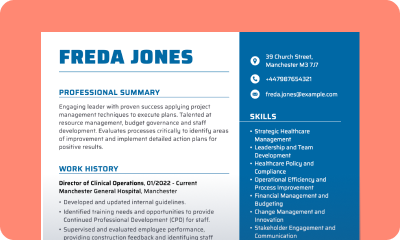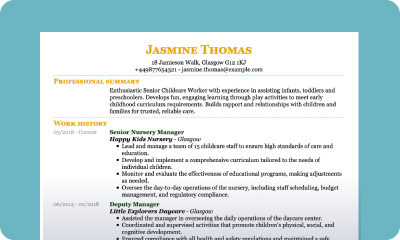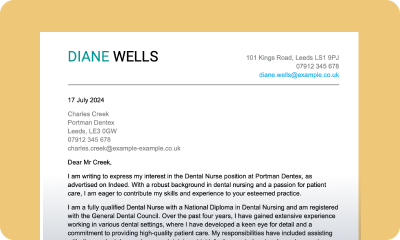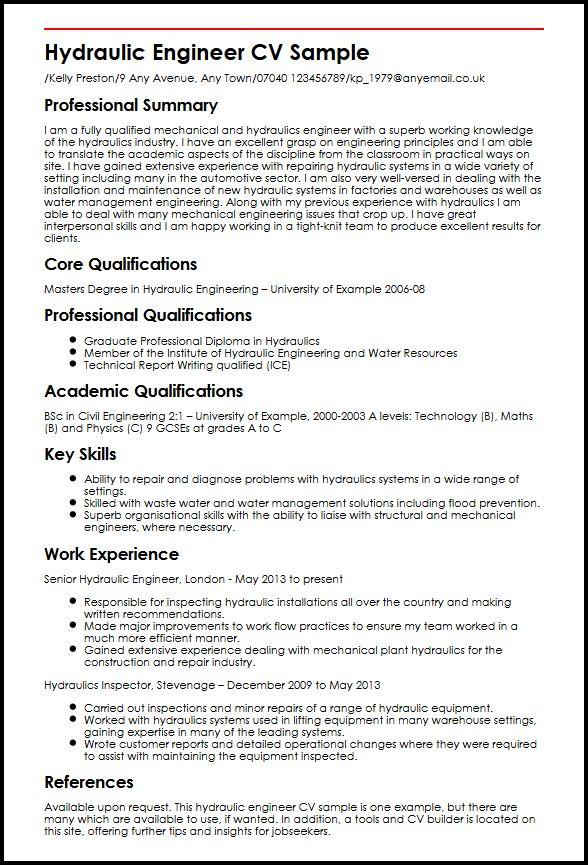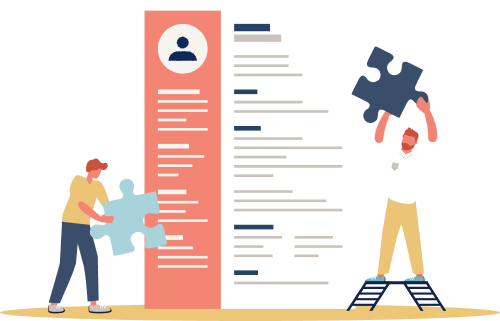Whether you’re an entry-level graduate or a senior professional, knowing how to write an engineering CV is essential for career progression. Recruiters expect to see a clear summary of your technical skills, professional experience, and the measurable impact of your work.
This section will guide you through the process of writing an engineering CV, breaking it down into simple steps that ensure your application is tailored, professional, and career-focused.
STEP 1List your contact details
The first step in writing an effective engineering CV is to include your contact details at the very top of the page. Recruiters and hiring managers need to reach you quickly, so this section should be clear, concise, and professional.
Your contact section should include:
- Full name – written in bold at the top of your CV.
- Job title – Your current job position, e.g., Civil Engineer.
- Phone number – your personal mobile number, not a shared line.
- Professional email address – ideally firstname.lastname@email.com. Avoid casual or outdated addresses.
- Location – your city and region are usually enough. Full addresses are no longer necessary.
- Professional links – include your LinkedIn profile, GitHub (for software engineers), or portfolio if relevant.
A professional contact header has a simple job. It makes it easy for the recruiter to get in touch with you.
Example of a CV contact section:
David Dunne
Junior Design Engineer
London, UK
07912 345 678
david.dunne@example.co.uk
daviddportfolio.co.uk
STEP 2Lead with your personal statement
After your contact details, the next section of your engineering CV should be a short personal statement (sometimes called a CV profile or professional summary). This is a 3–4 sentence introduction that tells recruiters who you are, what you specialise in, and why you’re a strong fit for the role.
A good personal statement for an engineer should:
- Highlight your engineering discipline (e.g., civil, software, mechanical).
- Mention your years of experience or level of seniority.
- Showcase key technical skills or specialisms.
- Include a quantified achievement to demonstrate impact.
- Explain briefly how you can benefit the employer.
Keep it concise and focused. Avoid generic claims and buzzwords like “hard-working” or “team player”. Recruiters should immediately understand your value and relevance to the role.
By tailoring your personal statement to the job description, you make your CV for an engineer more targeted and more likely to stand out in a competitive market.
Sample 1: Junior Design Engineer
Motivated junior design engineer with a BEng in Mechanical Engineering and strong CAD proficiency. Completed a six-month internship where I contributed to the redesign of an automotive component, reducing material costs by 12%. Skilled in problem-solving and eager to apply creativity and technical knowledge to support innovative projects at company ABC.
OR
Sample 2: Software Engineer
Detail-oriented software engineer with 3 years’ experience developing web applications in JavaScript, React, and Node.js. Led the optimisation of an internal tool that cut data processing times by 40%, improving efficiency across multiple departments. Strong collaborator in agile environments, ready to deliver scalable software solutions that align with the business goals of XYZ Inc.
STEP 3List work experience on your engineering CV
Your work experience is often the most important part of an engineering CV. This section shows employers how you’ve applied your technical knowledge, problem-solving skills, and project management abilities in real-world situations.
List your roles in reverse chronological order, starting with the most recent. For each role, include:
- Job title – e.g., Civil Engineer, Design Engineer, Software Engineer.
- Company name and location.
- Dates of employment – month and year.
- Bullet points describing responsibilities and achievements.
When writing bullet points on your engineering CV, focus on impact and outcomes, not just duties. Use CV action words (developed, designed, implemented, optimised) and back up your work with quantified results wherever possible.
Example of work experience for an engineering CV:
Mechanical Engineer
GreenBuild Engineering Ltd, Manchester
March 2021 – Present
- Designed and tested HVAC systems for large-scale residential projects, achieving a 20% improvement in energy efficiency.
- Created detailed technical drawings and 3D models using AutoCAD and SolidWorks, ensuring compliance with UK building regulations.
- Collaborated with contractors and architects to deliver two major projects two weeks ahead of schedule.
Engineering Internship
InnovateTech Solutions, Birmingham
July 2020 – December 2020
- Supported the development of a prototype renewable energy system, contributing to a 12% reduction in material waste.
- Assisted in preparing technical documentation and test reports for client presentations, with 100% accuracy.
- Participated in team meetings and design reviews, gaining hands-on experience in cross-disciplinary collaboration.
STEP 4Highlight your engineering skills
The skills section of your engineering CV gives recruiters a quick overview of your technical expertise and personal strengths. Employers in engineering want candidates who not only know the tools of the trade but can also communicate, solve problems, and work in teams. That’s why this section should include a mix of hard skills (technical abilities) and soft skills (interpersonal strengths).
Some sample skills may include:
Hard skills for an engineering CV
- CAD design (AutoCAD, SolidWorks)
- Programming languages (Python, C++, JavaScript)
- Project management tools (MS Project, Primavera)
- Systems analysis
- Troubleshooting
- Quality assurance
- Compliance standards
- Blueprint reading
Soft skills for an engineering CV
STEP 5Add your education
The education section is a key part of any engineering CV, especially if you’re early in your career. Employers in engineering often set specific degree requirements, so your academic background should be listed clearly and professionally.
What to include in the education section of a CV for an engineer:
- Degree title – e.g., BEng Mechanical Engineering, MSc Civil Engineering.
- University name and location.
- Dates of study (include “Expected [year]” if still studying).
- Relevant modules or projects – only if they directly support the role you’re applying for.
- Academic achievements – such as a first-class degree, scholarships, or awards.
See this example:
BEng (Hons) Mechanical Engineering
University of Leeds, UK
September 2020 – June 2023
- Graduated with First Class Honours.
- Relevant modules: Computer-Aided Design (CAD), Thermodynamics, Materials Engineering, Product Design.
- Final-year project: Developed and tested a lightweight bicycle frame using SolidWorks and finite element analysis, achieving a 15% increase in strength-to-weight ratio.
If you’re a recent graduate or applying for an entry-level position, you can expand this section by mentioning coursework, dissertations, or group projects that show practical skills. For example: Final-year project: Designed and simulated a renewable energy system that reduced output variability by 15%.
For experienced engineers, keep this section concise and focus more on professional experience. Just list your degrees, along with any postgraduate qualifications, without expanding into modules.
STEP 6Include bonus sections to stand out
While the core of your engineering CV will be your experience, skills, and education, bonus sections can give you an extra edge in competitive fields. These optional additions show recruiters more of your professional development, achievements, and interests, helping you stand out from other applicants.
Useful bonus sections for a CV for an engineer include:
- Certifications – such as Lean Six Sigma, PMP, or AutoDesk certifications that prove specialist skills.
- Languages – highlight additional languages you speak, using a framework like CEFR to show proficiency levels.
- Projects – include side projects, open-source contributions, or freelance work that demonstrate initiative and problem-solving.
- Publications or research – list journal articles, conference presentations, or white papers if relevant to your field.
- Awards and honours – academic or industry awards that highlight excellence.
- Professional memberships – e.g., Institution of Mechanical Engineers (IMechE), Institution of Civil Engineers (ICE), or BCS for software engineers.
Only add bonus sections that add value to your application. For example, a software engineer CV that includes a list of finished coding projects will carry much more weight than unrelated hobbies and interests.
For example:
Certifications
- Lean Six Sigma Green Belt – IASSC, November 2022
- AutoDesk Certified Professional: AutoCAD – July 2021
- PRINCE2 Foundation in Project Management – January 2021
Projects
- Sustainable Bridge Design – Led a university capstone project to design a pedestrian bridge using recycled materials, achieving a 25% reduction in projected costs compared to standard designs.
- Open-Source CAD Plugin – Developed a SolidWorks plugin for rapid component testing, downloaded over 500 times by other engineering students and professionals.
STEP 7Format your engineering CV for clarity
Even the strongest content can be overlooked if your engineering CV isn’t well formatted. Recruiters often spend less than 10 seconds scanning a CV, so clear structure and readability are essential.
Format your CV for engineering jobs by following this blueprint:
- CV length: Keep it to two pages maximum. Entry-level engineers may only need one page, but experienced professionals can expand to two if content is relevant.
- Font choice: Use professional CV fonts like Arial, Calibri, or Times New Roman. Avoid decorative fonts that may look unprofessional.
- Font size: 10–12pt for body text and 14–16pt for headings. Consistency is key.
- Margins: Stick to 2–2.5 cm (about 1 inch) on all sides for balance and readability.
- Headings: Use bold or slightly larger fonts to make section titles stand out.
- Bullet points: Use concise bullet points rather than paragraphs to list responsibilities and achievements.
- White space: Leave enough spacing between sections so the CV doesn’t look cluttered.
- File format: Save and send your CV as a PDF unless the employer specifically requests Word format.
